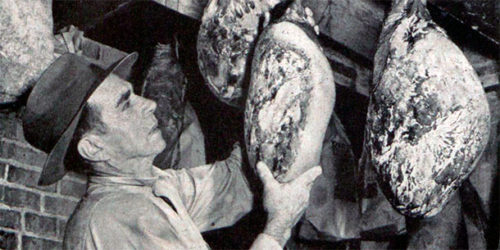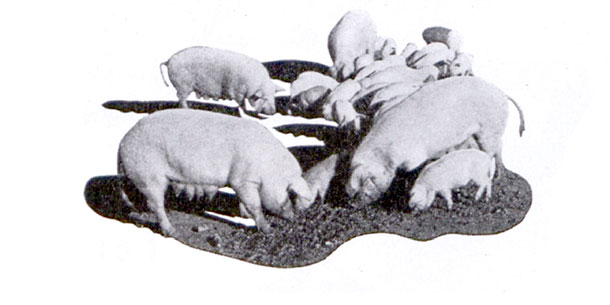Find out what it takes to preserve the meat that stars in croque monsieur, chicken cordon bleu, and Easter dinner. These four recipes represent “the pooled know-how of men who consistently produce the best in Georgia, Kentucky, and Missouri, where country-cured ham is supreme.”
Originally published in The Country Gentleman, November 1, 1950
Dry Cure by W.H. Gardner, Boone County, Missouri
For 100 pounds of meat:
- 8 pounds of salt
- 3 pounds of brown sugar
- 5 ounces of black pepper
- 2 ounces of saltpeter
Rub half the mixture thoroughly on the pieces and pack. At the end of five days, rub on the remainder of the cure. Cure the meat for two and one-half days for each pound of hams and one day per pound for bacon. Remove from cure and brush and smoke.
Variation
For each ham or shoulder from a 250-pound hog:
- 1 pint of good salt (decrease salt one-fourth or more for bacon pieces)
- 4 tablespoons brown sugar
- 1 tablespoon black pepper
- 1 scant teaspoon cayenne pepper
The ingredients should be mixed and warmed in a skillet, as warming helps the mixture to adhere to the meat. Spread on a table a piece of heavy glazed wrapping paper of sufficient size to wrap each piece of meat. Place the meat skin-side down on the paper and cover each piece with the hot mixture, being careful to press it into the joints and crevices of the meat surface. The meat is wrapped in the paper and each piece placed in a heavy muslin sack, being careful not to shake the mixture from the meat.
The pieces should be laid flesh side up on a table and allowed to remain a few days before hanging. Do not stack the meat. Care must be taken to have the meat thoroughly cooled but not frozen when the mixture is applied nor allowed to freeze if possible after the mixture is applied until curing is complete. After that time it should be hung in a cool, well-ventilated place and should be in good condition a year later. This method eliminates smoking, and if meat is smoked it is almost necessary under farm conditions to wrap it in paper and place in muslin bags to avoid losses from insects.
Light-on-the-Salt Cure by J. Alex Barber, Washington County, Kentucky
I use a very simple, mild cure. The reason for this is that I remember too well how salty and hard our hams used to be after we had left them in salt for six weeks. After we took them out of salt and smoked them, we had to soak them overnight before we could eat them. Even then, much of the outside lean was dry and unpalatable, practically inedible. …
Each ham is thoroughly rubbed with salt, and the surface covered with a light layer. Plenty of salt should be pushed into the shank around the hock joint. All joints should be regarded as critical points where spoilage may occur when the salt fails to get in its work there.
After three weeks in salt, hams are removed and the salt brushed off. Then they are dipped in boiling water and laid on a table. I follow this with an application of about two tablespoons of hot sorghum molasses to each ham. All of this will be absorbed by the following day. A light dusting of black pepper over the surface of the ham completes the curing routine.
Either hickory wood or corncobs produce a satisfactory smoke. I smoke for about four half-day intervals, during damp, muggy weather, if possible. Hams take the smoke better under these conditions. I keep close watch of the fire when I’m smoking, and try hard to keep down blazing. Hams are hung some four to five feet away from the fire. When smoked properly, the surface of the hams should be a nice amber color.
Immediately after smoking, I store each ham in a heavy paper bag. As I close the opening of the bag, I tie in some borax to keep out skippers, which are a problem in keeping hams. This method of keeping them out works well for me.
I age my hams for almost a year. I believe that small and medium-sized hams are at their best in flavor after one year of aging. Large hams may be improved some by additional aging. Flavor is about at peak when white spots appear. Mold on the surface of a ham does no harm to the flavor. In fact, I like to see mold on a ham.
If you want the full-blown savor of an old ham, slice and fry, or broil it. Serve with two fresh eggs alongside, and … you’ll be a man, my son!
Tried-and-True Cure by Thurman T. Scott, Thomasville, Georgia

Ten years to learn how to cure a good country ham sounds like a long time. Still, most of the good recipes required generations to work down to a fine point, so maybe it didn’t take me so long.
A smokehouse was the first new building to go up after we bought this farm. The very first fall, with high hopes and certain anticipation, I put up a big batch of hams. They were a total loss. Undaunted, the next fall I tried again and missed just as badly, though in a different way. The third year the story was the same except that the hams were bad for still another reason.
Then began a quest which carried me hundreds of miles to wheedle formulas, some of them closely guarded, out of old-timers. I wrote to experts the country over. Several years of sifting and studying and testing were required, strangely, before I realized the obvious fact that while each formula sounded sure-fire, there were elements of chance in every single one of them.
All of which was exactly what I didn’t want. I wanted a precise, exact system which would uniformly produce country-cured hams that I would know were just right before they were cut or baked; I wanted a formula which I could use year after year with full confidence.
I got it. For four years now, every ham I have put up has been just right, never a suggestion of taint or sour-bone, never the least bit over-salty, no parboiling or soaking required. And while there is some work to the method, it is so simple that a moron could do it, as I have demonstrated.
The basis of the curing mix is
- 6 pounds of salt
- 2 pounds of sugar
- 2 ounces of saltpeter
- pepper could be added for seasoning, if desired
Each ham is weighed and cured separately, 1.3 ounces of the mix for each pound of the ham being applied. (Example: a 20-pound ham gets 26 ounces of the curing mix.) The ham is placed on a large sheet of brown wrapping paper, some of its mix rubbed in thoroughly and the balance packed on, mostly on the meat or cut side.
Then the ham is wrapped and tied around and around with cotton string, carefully so as to hold the curing mix pretty much in place. I prefer to hang the hams, in clean cotton feed sacks, with the bone end down while curing, but the practice is not essential. It is highly essential, however, that the hams remain in a temperature of between 32° and 40°F, until completely cured. Minimum time for a ham to remain in cure is 2 days for each pound of the ham but never under 25 days, regardless of how small the ham. With this formula there is no danger of leaving the ham in cure too long, as the amount of salt prescribed is the exact quantity required, no more and no less.
After the curing the ham may be removed, washed and smoked if desired, or else left in the wrapping for its aging. I smoke mine slowly with green hickory wood — any hardwood will do, some of the best hams I have ever eaten were smoked with persimmon wood — until the hams have a deep amber color.
Much is heard about “sugar-cured” hams, but sugar doesn’t cure. Salt does the curing; some sugar is added to the curing mix to counteract the salt taste which would otherwise be left in the meat. Saltpeter is included to hasten the chemical action of the salt on the meat and to improve the color of the meat. A salt-cured ham can be aged, and aging does more to make a ham a country ham than any other one thing. Under six months a ham is still pork, the meat pale and pink, but after that a ham starts to become a ham with full flavor and red meat. When you get right down to cases, the only reason for salt-curing a ham is so that it can be aged.
Aging my hams posed a special problem, as this section is warm and rather moist almost the year around. I cured them in the cool room of the local ice plant but found, if aged there, the hams acquired a slight off-flavor. If I aged them in a non-refrigerated room or building they were beset with flies, worms, and bugs as well as an undesirable wet mold, wrap or coat them as I might. Hams cannot be sealed up airtight, because a certain amount of gas, which must be allowed to escape, is released during the curing process.
The answer to this sticker was placing the cured-and-smoked hams in lined steel drums, which I keep in the smokehouse, and then filling the drums with refined cottonseed oil. A good, sweet grade of crude cottonseed oil would do. Lids cover the drums, but not airtight. Thus covered with oil, the hams are not molested by insects or mold and, importantly, there is little or no dehydration. They do not shrink and get hard but stay as soft and tender as when they were put in the oil. Then my only problem is to refrain from eating the hams until they’ve acquired a year’s aging.
Hogs should be starved for about 24 hours before slaughter, carcasses thoroughly chilled before dressing. Hams should be placed in the cure immediately — and watch that temperature! It is important. From then on only the cool temperature will permit the salt to penetrate the fat and the lean and the skin and the bone before spoilage bacteria get the upper hand.
Whenever you get a good country ham, regardless of what method was used to cure and age it, you’ve really got something.
Become a Saturday Evening Post member and enjoy unlimited access. Subscribe now




Comments
I was just a youngster when we cured ham. But I do remember we never , never used any kink of sugar.